wheel PONTIAC GRAND AM 1998 Owner's Manual
[x] Cancel search | Manufacturer: PONTIAC, Model Year: 1998, Model line: GRAND AM, Model: PONTIAC GRAND AM 1998Pages: 370, PDF Size: 16.11 MB
Page 132 of 370
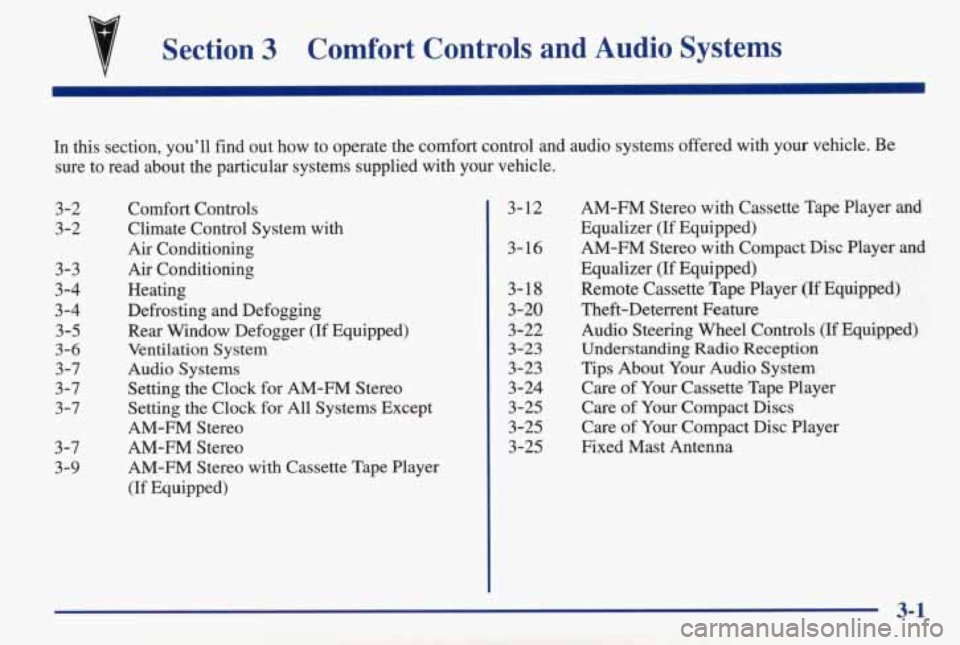
Section 3 Comfort Controls and Audio Systems
In this section, you’ll find out how to operate the comfort control and audio systems offered w\
ith your vehicle. Be
sure to read about the particular systems supplied with your v\
ehicle.
3-2
3-2
3-3
3-4
3-4
3-5
3-6
3-7
3-7
3-7
3-7
3-9
Comfort Controls
Climate Control System
with
Air Conditioning
Air Conditioning
Heating
Defrosting and Defogging
Rear Window Defogger
(If Equipped)
Ventilation System
Audio Systems
Setting the Clock for
AM-FM Stereo
Setting the Clock for
All Systems Except
AM-EM Stereo
AM-FM Stereo
AM-FM Stereo with Cassette Tape Player
(If Equipped)
3-12
3-
16
3-18
3-20
3-22
3-23
3-23
3-24
3-25 3-25
3-25
AM-FM Stereo with Cassette Tape Player and
Equalizer
(If Equipped)
AM-FM Stereo with Compact Disc Player and
Equalizer (If Equipped)
Remote Cassette Tape Player
(If Equipped)
Theft-Deterrent Feature Audio Steering Wheel Controls
(If Equipped)
Understanding Radio Reception
Tips About
Your Audio System
Care of Your Cassette Tape Player
Care
of Your Compact Discs
Care
of Your Compact Disc Player
Fixed Mast Antenna
Page 153 of 370
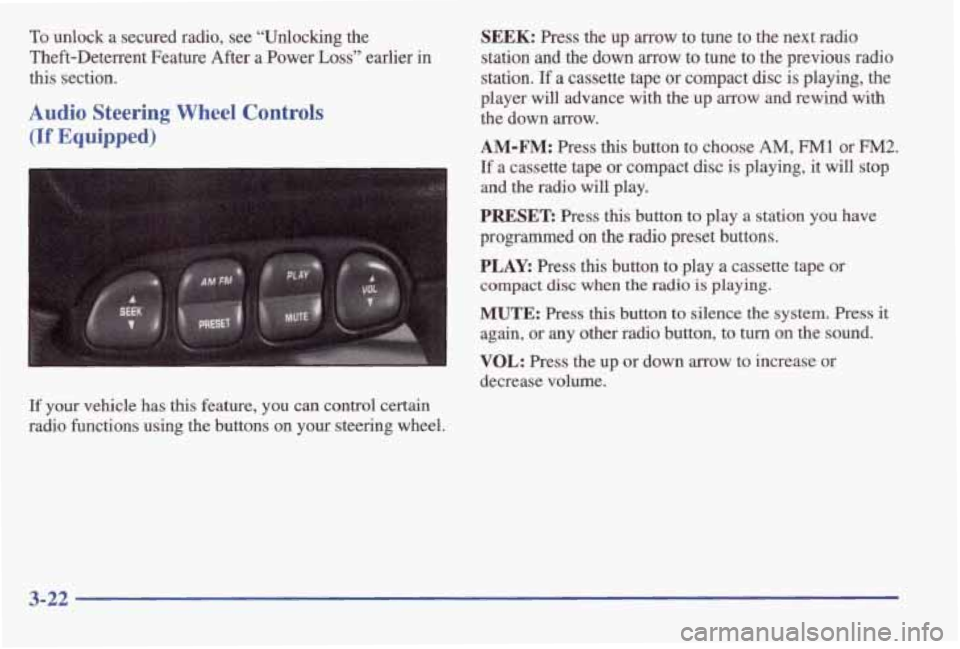
To unlock a secured radio, see “Unlocking the
Theft-Deterrent Feature After
a Power Loss” earlier in
this section.
Audio Steering Wheel Controls
(If Equipped)
SEEK: Press the up arrow to tune to the next radio
station and
the down arrow to tune to the previous radio
station.
If a cassette tape or compact disc is playing, the
player
will advance with the up arrow and rewind with
the down arrow.
AM-FM: Press this button to choose AM, FM1 or FM2.
If a cassette tape or compact disc is playing, it will stop
and the radio will play.
PRESET: Press this button to play a station you have
programmed
on the radio preset buttons.
PLAY: Press this button to play a cassette tape or
compact
disc when the radio is playing.
MUTE: Press this button to silence the system. Press it
again, or any other radio button, to turn on the sound.
I VOL: Press the up or down arrow to increase or
decrease volume.
If your vehicle has
this feature, you can control certain
radio functions using the buttons
on your steering wheel.
3-22
Page 166 of 370
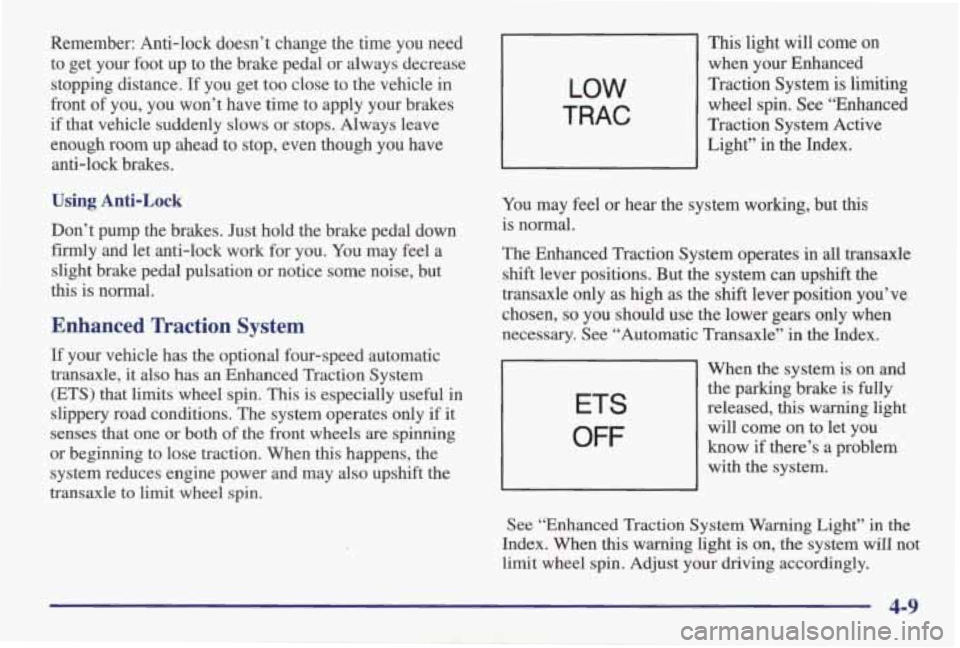
Remember: Anti-lock doesn’t change the time you need to get your foot up to the brake pedal or always decrease
stopping distance.
If you get too close to the vehicle in
front of you, you won’t have time to apply your brakes
if that vehicle suddenly slows or stops. Always leave
enough room up ahead to stop, even though you have
anti-lock brakes.
Using Anti-Lock
Don’t pump the brakes. Just hold the brake pedal down
firmly and let anti-lock work for you. You may feel a
slight brake pedal pulsation
or notice some noise, but
this is normal.
Enhanced Traction System
If your vehicle has the optional four-speed automatic
transaxle,
it also has an Enhanced Traction System
(ETS) that limits wheel spin. This is especially useful in
slippery road conditions. The system operates only if it
senses that one
or both of the front wheels are spinning
or beginning to lose traction. When this happens, the
system reduces engine power and may also upshift the
transaxle
to limit wheel spin.
LOW
TRAC
This light will come on
when your Enhanced
Traction System
is limiting
wheel spin. See “Enhanced
Traction System Active
Light” in the Index.
You may
feel or hear the system working, but this
is normal.
The Enhanced Traction System operates
in all transaxle
shift lever positions. But the system can upshift the
transaxle only as high
as the shift lever position you’ve
chosen,
so you should use the lower gears only when
necessary. See “Automatic Transaxle” in the Index.
ETS
OFF
When the system is on and
the parking brake is fully
released,
this warning light
will come on to let you
know
if there’s a problem
with the system.
See “Enhanced Traction System
Warning Light” in the
Index. When
this warning light is on, the system will not
limit wheel spin. Adjust your driving accordingly.
4-9
Page 167 of 370
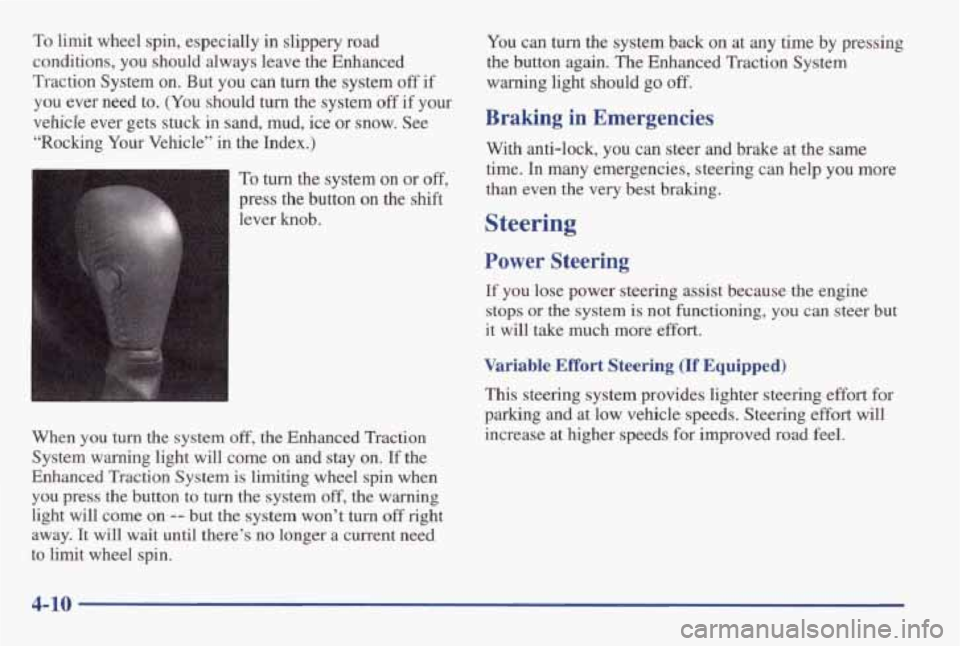
To limit wheel spin, especially in slippery road
conditions, you should always leave the Enhanced
Traction System
on. But you can turn the system off if
you ever need to. (You should turn the system off if your
vehicle ever gets stuck in sand, mud, ice
or snow. See
“Rocking Your Vehicle” in
the Index.)
To turn the system on or off,
press the button on the shift
lever knob.
When
you turn the system off, the Enhanced Traction
System warning light will come on
and stay on. If the
Enhanced Traction System is limiting wheel spin when
you press the button to
turn the system off, the warning
light will come on
-- but the system won’t turn off right
away. It
will wait until there’s no longer a current need
to limit wheel spin. You
can turn the system
back on at any time by pressing
the button again. The Enhanced Traction System
warning light should go off.
Braking in Emergencies
With anti-lock, you can steer and brake at the same
time. In many emergencies, steering can help you more
than even the
very best braking.
Steering
Power Steering
If you lose power steering assist because the engine
stops
or the system is not functioning, you can steer but
it will take much more effort.
Variable Effort Steering (If Equipped)
This steering system provides lighter steering effort for
parking and at low vehicle speeds. Steering effort will
increase at higher speeds for improved road feel.
4-10
Page 168 of 370
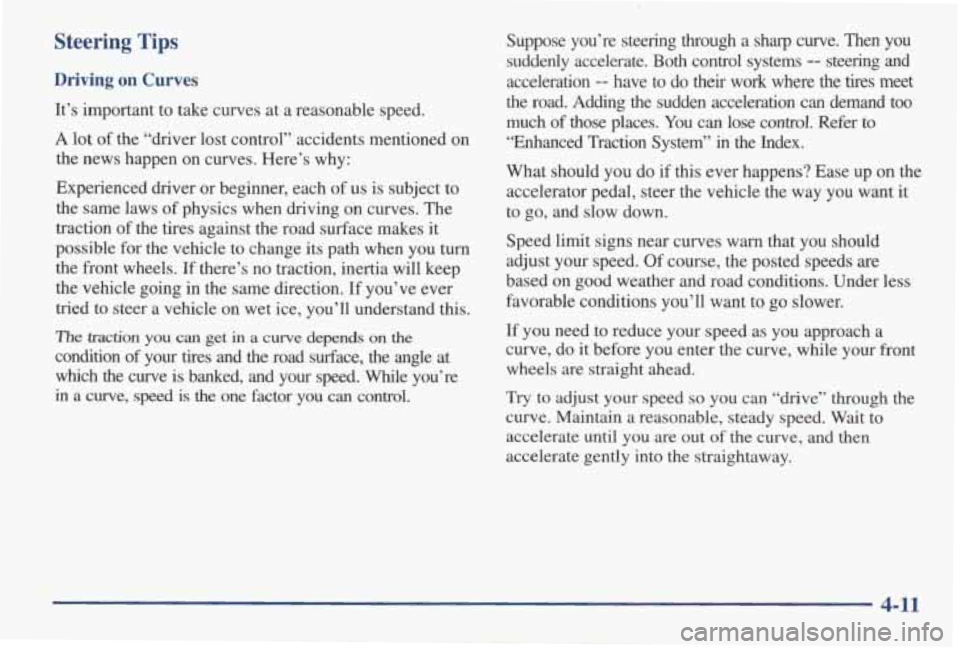
Steering Tips
Driving on Curves
It’s important to take curves at a reasonable speed.
A lot of the “driver lost control” accidents mentioned on
the news happen on curves. Here’s why:
Experienced driver or beginner, each of
us is subject to
the same laws of physics when driving
on curves. The
traction of the tires against the road surface makes it
possible for the vehicle to change its path when you
turn
the fkont wheels. If there’s no traction, inertia will keep \
the vehicle going in the same direction. If you’ve ever
tried to steer a vehicle on wet ice, you’ll understand this\
.
The traction you can get in a curve depends on the
condition of your tires and the road surface, the angle at
which the curve is banked, and your
speed. While you’re
in a curve, speed is the one factor you can control. Suppose you’re steering through
a sharp curve. Then you
suddenly accelerate. Both control systems
-- steering and
acceleration
-- have to do their work where the tires meet
the road.
Adding the sudden acceleration can demand too
much of those places.
You can lose control. Refer to
“Enhanced Traction System”
in the Index.
What should you do
if this ever happens? Ease up on the
accelerator pedal, steer the vehicle the way you want it
to go, and slow down.
Speed limit signs near curves warn that you should
adjust your speed. Of course, the posted speeds
are
based on good weather and road conditions. Under less
favorable conditions you’ll want to go slower.
If you need to reduce your speed as you approach a
curve, do it before you enter the curve, while your front
wheels are straight ahead.
Try to adjust your speed so you can “drive” through the
curve. Maintain a reasonable, steady speed. Wait to
accelerate until you are out
of the curve, and then
accelerate gently into the straightaway.
4-11
Page 169 of 370
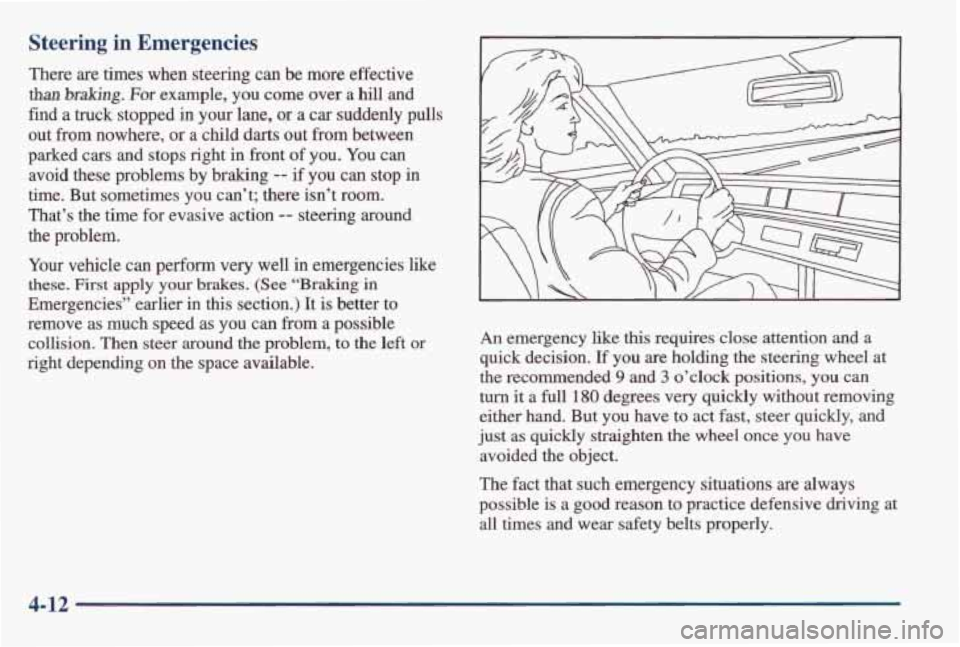
Steering in Emergencies
There are times when steering can be more effective
than braking. For example, you come over a hill and
find a truck stopped
in your lane, or a car suddenly pulls
out
from nowhere, or a child darts out from between
parked
cars and stops right in front of you. You can
avoid these problems by
braking -- if you can stop in
time. But sometimes you can’t; there isn’t room.
That’s the time for evasive action
-- steering around
the problem.
Your vehicle can perform very well in emergencies like
these. First apply your brakes. (See “Braking in
Emergencies” earlier in this section.) It is better to
remove
as much speed as you can from a possible
collision. Then
steer around the problem, to the left or
right depending on the space available.
An emergency like this requires close attention and a
quick decision.
If you are holding the steering wheel at
the recommended
9 and 3 o’clock positions, you can
turn it a full 180 degrees very quickly without removing
either hand. But you have to act fast, steer quickly, and
just
as quickly straighten the wheel once you have
avoided
the object.
The fact that such emergency situations
are always
possible is a good reason to practice defensive driving at
all times and wear safety belts properly.
4112
Page 170 of 370
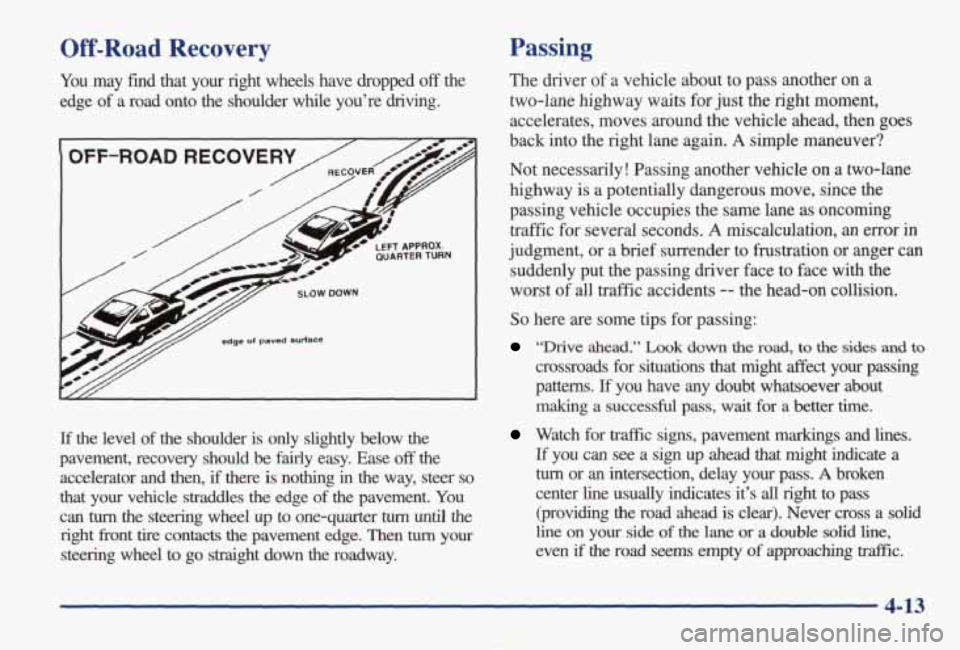
Off-Road Recovery
You may find that your right wheels have dropped off the
edge of a
road onto the shoulder while you’re driving.
If the level of the shoulder is only slightly below the
pavement, recovery should
be fairly easy. Ease off the
accelerator and then,
if there is nothing in the way, steer so
that your vehicle straddles the edge of the pavement. You
can tum the steering wheel up to one-quarter turn until the
right fkont tire contacts the pavement edge. Then turn your
steering wheel to go straight down the roadway.
Passing
The driver of a vehicle about to pass another on a
two-lane highway waits for just the right moment,
accelerates, moves around the vehicle ahead, then
goes
back into the right lane again. A simple maneuver?
Not necessarily! Passing another vehicle on a two-lane
highway is a potentially dangerous move, since the
passing vehicle occupies the same lane
as oncoming
trafEc for several seconds.
A miscalculation, an error in
judgment, or
a brief surrender to frustration or anger can
suddenly
put the passing driver face to face with the
worst of all tr&k accidents -- the head-on collision.
So here are some tips for passing:
“Drive ahead.” Look down the road, to the sides and to
crossroads for situations that might affect your passing
patterns. If you have any doubt whatsoever about
making a successful pass, wait for a better time.
Watch for traffic signs, pavement markings and lines.
If you can see a sign up ahead that might indicate a
turn or an intersection, delay your pass. A broken
center line usually indicates it’s all right to pass (providing the road ahead is clear). Never
cross a solid
line on your side of the lane or a double solid line,
even if the road seems empty of approaching traffic.
4-13
Page 172 of 370
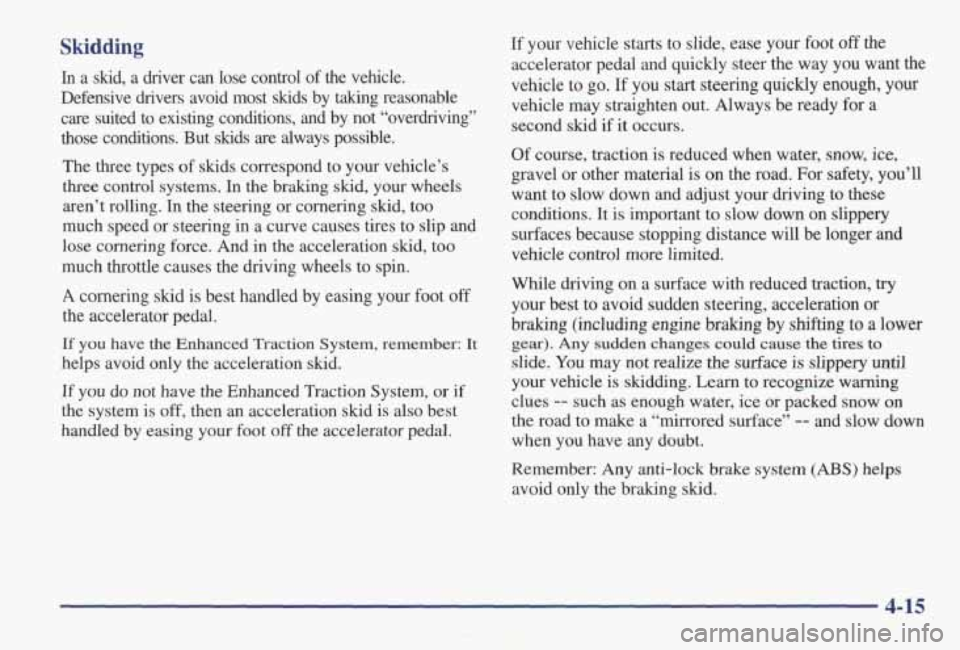
Skidding
In a skid, a driver can lose control of the vehicle.
Defensive
drivers avoid most skids by taking reasonable
care
suited to existing conditions, and by not “overdriving”
those conditions. But skids are always possible.
The three types of skids correspond to your vehicle’s
three control systems. In the braking
skid, your wheels
aren’t rolling.
In the steering or cornering skid, too
much speed or steering in a curve causes tires to slip and
lose cornering force. And in the acceleration skid, too
much throttle causes the driving wheels
to spin.
A cornering skid is best handled by easing your foot off
the accelerator pedal.
If you have the Enhanced Traction System, remember: It
helps avoid only the acceleration skid.
If you do not have the Enhanced Traction System, or if
the system is
off, then an acceleration skid is also best
handled
by easing your foot off the accelerator pedal.
If your vehicle starts to slide, ease your foot off the
accelerator pedal and quickly steer the way you want
the
vehicle to go. If you start steering quickly enough, your
vehicle may straighten out. Always be ready for
a
second skid if it occurs.
Of course, traction is reduced when water, snow, ice,
gravel or other material is
on the road. For safety, you’ll
want to slow down and adjust your driving to these
conditions. It is important to slow down on slippery
surfaces because stopping distance will be longer and
vehicle control more limited.
While driving on a surface with reduced traction,
try
your best to avoid sudden steering, acceleration or
braking (including engine braking by shifting
to a lower
gear). Any sudden changes could cause the tires to
slide. You may not realize the surface is slippery until
your vehicle is skidding.
Learn to recognize warning
clues
-- such as enough water, ice or packed snow on
the road to make
a “mirrored surface” -- and slow down
when you have any doubt.
Remember: Any anti-lock brake system
(ABS) helps
avoid only the braking
skid.
4-15
Page 181 of 370
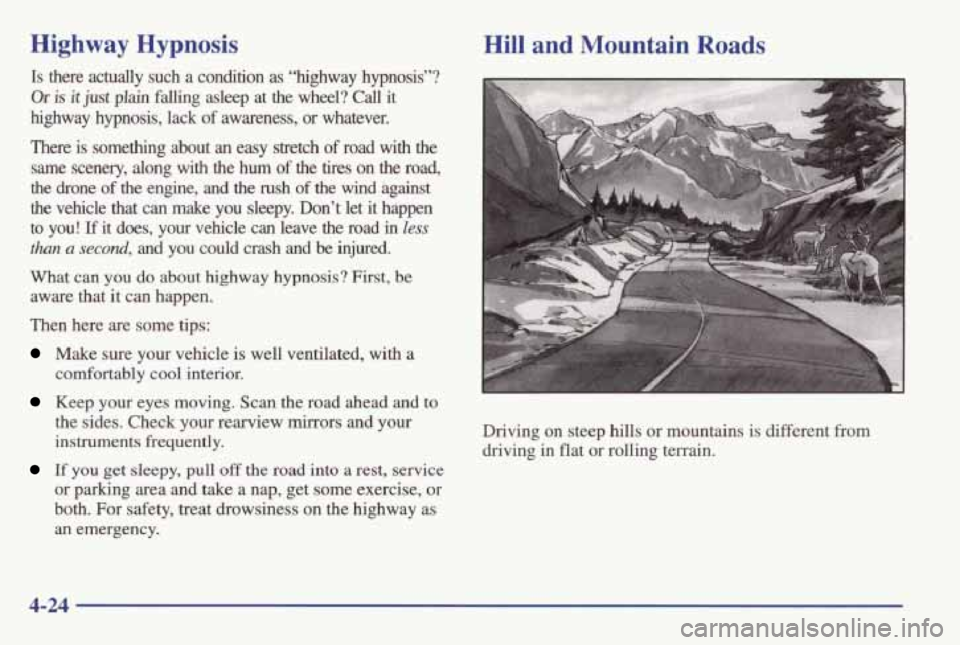
Highway Hypnosis
Is there actually such a condition as “highway hypnosis”?
Oris it@ plain falling asleep at the wheel? Call it
highway hypnosis, lack
of awareness, or whatever.
There is something about
an easy stretch of road with the
same scenery,
along with the hum of the tires on the road,
the drone of the engine, and the rush of the wind against
the vehicle that can make you sleepy. Don’t let it happen
to you!
If it does, your vehicle can leave the road in less
than a second, and you could crash and be injured.
What can you do about highway hypnosis? First, be aware that
it can happen.
Then here are some tips:
Make sure your vehicle is well ventilated, with a
comfortably cool interior.
Keep your eyes moving. Scan the road ahead and to
the sides. Check your rearview mirrors and
your
instruments frequently.
If you get sleepy, pull off the road into a rest, service
or parking area and take a nap, get some exercise, or
both. For safety, treat drowsiness on the highway as
an emergency.
Hill and Mountain Roads
Driving on steep hills or mountains is different from
driving in flat or rolling terrain.
4-24
Page 184 of 370
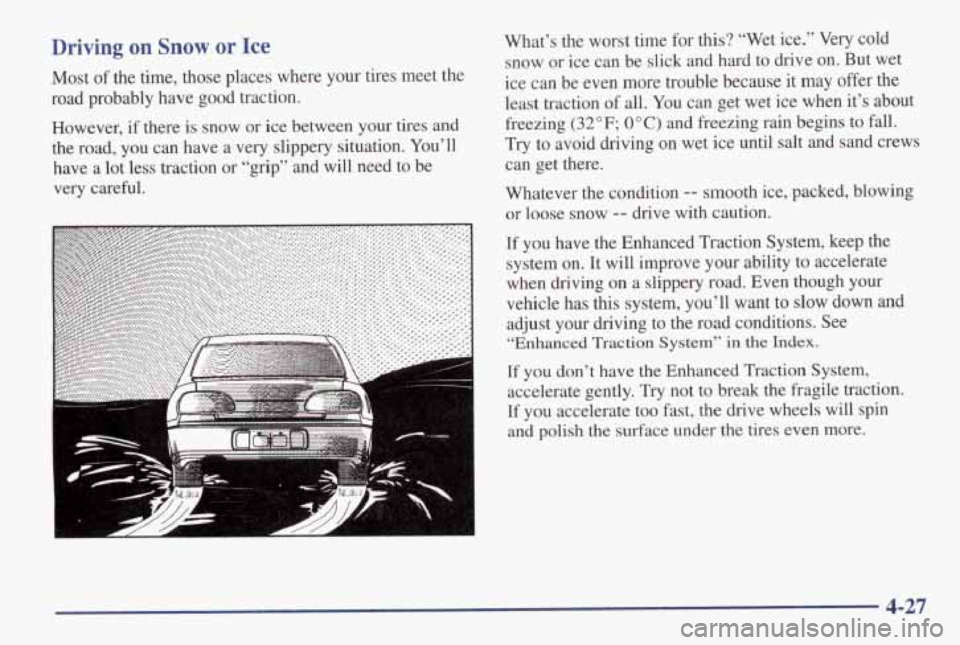
Driving on Snow or Ice
Most of the time, those places where your tires meet the
road probably have good traction.
However, if there is snow
or ice between your tires and
the road, you can have a very slippery situation. You’ll have a lot less traction or “grip” and will need to be \
very careful.
4
What’s the worst time for this? “Wet ice.” Very cold
snow
or ice can be slick and hard to drive on. But wet
ice can be even more trouble because it may offer the
least traction
of all. You can get wet ice when it’s about
freezing
(32 OF; 0” C) and freezing rain begins to fall.
Try to avoid driving on
wet ice until salt and sand crews
can get there.
Whatever the condition
-- smooth ice, packed, blowing
or loose snow
-- drive with caution.
If you have the Enhanced Traction System, keep the
system on, It will improve your ability to accelerate
when driving on a slippery road. Even though your
vehicle has
this system, you’ll want to slow down and
adjust your driving to the road conditions. See
“Enhanced Traction System” in the Index.
If you don’t have the Enhanced Traction System,
accelerate gently. Try not to break the fragile traction.
If you accelerate too fast, the
drive wheels will spin
and polish the surface under the tires even more.
4-27